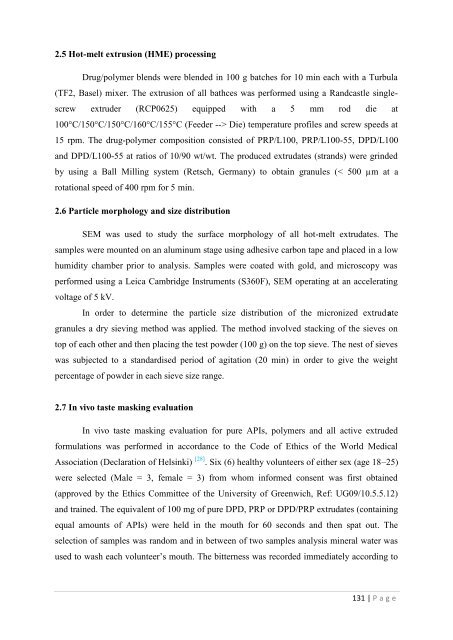Development of hot-melt extrusion as a novel technique for the ...
Development of hot-melt extrusion as a novel technique for the ...
Development of hot-melt extrusion as a novel technique for the ...
Create successful ePaper yourself
Turn your PDF publications into a flip-book with our unique Google optimized e-Paper software.
2.5 Hot-<strong>melt</strong> <strong>extrusion</strong> (HME) processingDrug/polymer blends were blended in 100 g batches <strong>for</strong> 10 min each with a Turbula(TF2, B<strong>as</strong>el) mixer. The <strong>extrusion</strong> <strong>of</strong> all bathces w<strong>as</strong> per<strong>for</strong>med using a Randc<strong>as</strong>tle singlescrewextruder (RCP0625) equipped with a 5 mm rod die at100°C/150°C/150°C/160°C/155°C (Feeder --> Die) temperature pr<strong>of</strong>iles and screw speeds at15 rpm. The drug-polymer composition consisted <strong>of</strong> PRP/L100, PRP/L100-55, DPD/L100and DPD/L100-55 at ratios <strong>of</strong> 10/90 wt/wt. The produced extrudates (strands) were grindedby using a Ball Milling system (Retsch, Germany) to obtain granules (< 500 µm at arotational speed <strong>of</strong> 400 rpm <strong>for</strong> 5 min.2.6 Particle morphology and size distributionSEM w<strong>as</strong> used to study <strong>the</strong> surface morphology <strong>of</strong> all <strong>hot</strong>-<strong>melt</strong> extrudates. Thesamples were mounted on an aluminum stage using adhesive carbon tape and placed in a lowhumidity chamber prior to analysis. Samples were coated with gold, and microscopy w<strong>as</strong>per<strong>for</strong>med using a Leica Cambridge Instruments (S360F), SEM operating at an acceleratingvoltage <strong>of</strong> 5 kV.In order to determine <strong>the</strong> particle size distribution <strong>of</strong> <strong>the</strong> micronized extrudategranules a dry sieving method w<strong>as</strong> applied. The method involved stacking <strong>of</strong> <strong>the</strong> sieves ontop <strong>of</strong> each o<strong>the</strong>r and <strong>the</strong>n placing <strong>the</strong> test powder (100 g) on <strong>the</strong> top sieve. The nest <strong>of</strong> sievesw<strong>as</strong> subjected to a standardised period <strong>of</strong> agitation (20 min) in order to give <strong>the</strong> weightpercentage <strong>of</strong> powder in each sieve size range.2.7 In vivo t<strong>as</strong>te m<strong>as</strong>king evaluationIn vivo t<strong>as</strong>te m<strong>as</strong>king evaluation <strong>for</strong> pure APIs, polymers and all active extruded<strong>for</strong>mulations w<strong>as</strong> per<strong>for</strong>med in accordance to <strong>the</strong> Code <strong>of</strong> Ethics <strong>of</strong> <strong>the</strong> World MedicalAssociation (Declaration <strong>of</strong> Helsinki) [28] . Six (6) healthy volunteers <strong>of</strong> ei<strong>the</strong>r sex (age 18–25)were selected (Male = 3, female = 3) from whom in<strong>for</strong>med consent w<strong>as</strong> first obtained(approved by <strong>the</strong> Ethics Committee <strong>of</strong> <strong>the</strong> University <strong>of</strong> Greenwich, Ref: UG09/10.5.5.12)and trained. The equivalent <strong>of</strong> 100 mg <strong>of</strong> pure DPD, PRP or DPD/PRP extrudates (containingequal amounts <strong>of</strong> APIs) were held in <strong>the</strong> mouth <strong>for</strong> 60 seconds and <strong>the</strong>n spat out. Theselection <strong>of</strong> samples w<strong>as</strong> random and in between <strong>of</strong> two samples analysis mineral water w<strong>as</strong>used to w<strong>as</strong>h each volunteer‘s mouth. The bitterness w<strong>as</strong> recorded immediately according to131 | P a g e
















